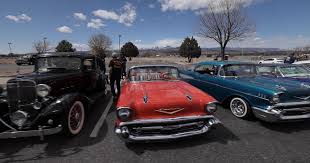Rob Vanderslice, a legendary lowrider painter, has transformed his life from working on cars for gangs and battling crystal meth addiction to now being hired by the Albuquerque Police Department to paint their vehicles. His personal journey of rehabilitation symbolizes the broader transformation of New Mexico’s lowrider culture, which is moving away from its associations with drugs and gangs to become a symbol of art, pride, and community service.
Lowriders are customized cars with lowered chassis and hydraulics that allow them to perform impressive stunts, such as bouncing and tilting. The cars, often Cadillac, Pontiac, or Chevy models, are adorned with intricate paint jobs, detailed engravings, and lavish interiors. They are labor-intensive projects, sometimes costing tens of thousands of dollars, that draw attention wherever they go.
The roots of lowrider culture in New Mexico trace back to the post-World War II era when many Mexican-Americans returned home to find themselves treated as second-class citizens. In response, they created a counterculture, using their cars as a form of self-expression and defiance.
In the late 1980s, lowriders were popularized in gangster rap videos, leading to a negative stereotype linking them to gangs and crime. Vanderslice, who began painting lowriders during this time, admitted to working with gangs in the early years. However, after his third criminal conviction, Vanderslice turned his life around. Now, 13 years sober, he paints lowriders for clients such as the Albuquerque Police Department.
This shift in perspective reflects a broader change in how lowriders are viewed. In 2016, the city of Santa Fe officially lifted its ban on cruising and declared a Lowrider Day, recognizing the cars as an important cultural and artistic tradition. Lowriders are no longer seen as symbols of rebellion and crime but as works of art and expressions of pride.
Joan and Arthur Medina, residents of Española, New Mexico, exemplify this transformation. Arthur’s lowrider, a prized possession, is part of a makeshift museum outside their home. The Medinas, along with other lowrider enthusiasts, use their cars as a platform for community service, helping to organize clothing drives and providing meals for children in need.
Patricia Trujillo, a college professor and expert on lowrider culture, sees this cultural shift as a move from rebellion to healing. “Rebellion now is healing,” she says, with lowriders becoming a beacon of hope for the community.
The Española Valley, known as the lowrider capital of the world, faces high poverty and crime rates. Organizations like the YMCA Teen Center, led by Ben Sandoval, are using lowriders to offer at-risk youth a sense of belonging and purpose. With support from the Drug Enforcement Administration, Sandoval’s center runs a program where teens design and build lowrider bicycles. These bikes, displayed in the Museum of Spanish Colonial Art in Santa Fe, represent the creative potential and hope for the future of Española’s youth.
Lowriders have evolved from a symbol of rebellion to a force for community engagement, art, and empowerment. They offer a powerful reminder of the transformative potential of New Mexico’s once-misunderstood culture.




![Tyson Foods Plant [Photo: Food Manufacturing]](https://southarkansassun.com/wp-content/uploads/2023/08/iStock_1185520857__1_.5e441daa51cca-600x337.jpg)







![Silverado Senior Living Management Inc. [Photo: Los Angeles Times]](https://southarkansassun.com/wp-content/uploads/2023/10/download-6-4-600x337.jpg)

![China's Wuhan Institute of Virology [Photo: Nature]](https://southarkansassun.com/wp-content/uploads/2023/09/d41586-021-01529-3_19239608-600x337.jpg)
















